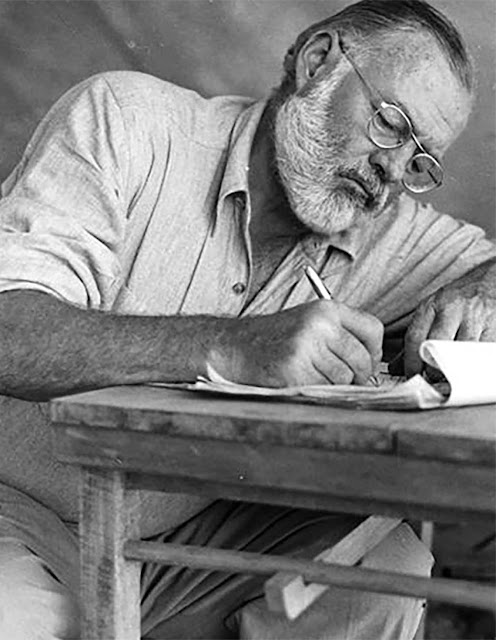 |
Ernest Hemingway |
Ernest Hemingway was an American novelist and short story writer, widely regarded as
one of the most influential writers of the 20th century. He was born on July
21, 1899, in Oak Park, Illinois, to Clarence and Grace Hemingway. Hemingway's
upbringing was relatively strict, as his father was a physician who expected
his son to pursue a career in medicine. However, Hemingway developed a passion
for writing from an early age and often contributed to his high school
newspaper.
:A life fighter
After
graduating from high school in 1917, Hemingway worked briefly as a reporter for
The Kansas City Star. He volunteered as an ambulance driver during World War I
and was stationed in Italy. His experiences during the war deeply influenced
his writing, as he witnessed the horrors of combat and the impact it had on the
human psyche.
Following
the war, Hemingway moved to Paris in the 1920s, where he joined the expatriate
community of writers and artists known as the "Lost Generation." He
became friends with notable figures such as Gertrude Stein, F. Scott
Fitzgerald, and Ezra Pound. It was in Paris that Hemingway honed his
distinctive writing style, characterized by concise, straightforward prose and
a focus on themes of love, war, and loss.
Hemingway's
first major work, "The Sun Also Rises" (1926), was a novel that
captured the disillusionment and aimlessness of the post-war generation. It
centers around a group of American and British expatriates who travel to
Pamplona, Spain, to witness the running of the bulls and the bullfights. The
novel received critical acclaim and marked Hemingway as a prominent literary
figure.
In
1927, Hemingway married his first wife, Hadley Richardson. They had a son named
John (nicknamed "Bumby") and seemed to have a happy life together.
However, as Hemingway's fame grew, so did his restlessness, and he started to
have affairs, leading to the breakdown of his marriage with Hadley.
Hemingway
went on to write several other successful novels, including "A Farewell to
Arms" (1929), a semi-autobiographical account of his experiences as an
ambulance driver in World War I and his love affair with a nurse; "For
Whom the Bell Tolls" (1940), set during the Spanish Civil War; and "The
Old Man and the Sea" (1952), a novella that earned him the Pulitzer Prize
and the Nobel Prize in Literature.
:Short story writer
In
addition to his novels, Hemingway was known for his short stories, many of
which are considered masterpieces of the form. Some of his famous short stories
include "The Killers," "Hills Like White Elephants," and
"The Snows of Kilimanjaro."
Despite
his literary success, Hemingway's personal life was tumultuous. He married
three more times after his divorce from Hadley, with his other wives being
Pauline Pfeiffer, Martha Gellhorn, and Mary Welsh. Hemingway's love for
adventure and danger also led him to participate in various activities, such as
big-game hunting, deep-sea fishing, and bullfighting.
Tragically,
Hemingway's mental health began to deteriorate in the later years of his life.
He suffered from depression and alcoholism, which impacted his writing and
relationships. On July 2, 1961, Ernest Hemingway died by suicide at his home in
Ketchum, Idaho.
Despite
his untimely death, Hemingway's literary legacy continues to be celebrated and
studied worldwide. His writing style and themes have influenced generations of
writers, and his works remain popular and widely read to this day. Ernest
Hemingway's impact on literature and his contribution to the modernist movement
ensure that he will always be remembered as one of the greatest writers in
American literary history.
:Special
writings
Ernest
Hemingway's writings are special and have left a lasting impact for several
reasons:
Writing
Style: Hemingway is renowned for his distinctive and influential writing style.
He embraced a minimalist approach, characterized by short, simple sentences and
an economy of words. His prose is straightforward, devoid of unnecessary
adjectives and adverbs, and conveys a sense of realism and clarity. This style,
often referred to as "Hemingwayesque" or "Hemingwayian,"
has been widely imitated by writers across different genres.
Themes
of Life and Death: Hemingway's works frequently explore profound themes of
life, death, love, war, loss, and human resilience. His experiences as an
ambulance driver during World War I and his love for adventure and danger
informed much of his writing. The theme of the "code hero" is also
prevalent in his works, embodying characters who face life's challenges with
courage, grace, and a stoic acceptance of the inevitability of death.
The
Iceberg Theory (Theory of Omission): Hemingway often employed the "Iceberg
Theory" in his writing, also known as the "Theory of Omission."
He believed that the deeper meaning and emotions of a story should remain
hidden beneath the surface, much like the larger part of an iceberg submerged
underwater. This approach allowed readers to infer and interpret the underlying
emotions and themes, creating a sense of engagement and intellectual
involvement.
Realism
and Authenticity: Hemingway's stories often draw from his real-life
experiences, adding a sense of authenticity to his characters and settings. His
journalistic background also influenced his storytelling, emphasizing a focus
on realistic dialogue and vivid descriptions.
Influence on Modernist Literature: Hemingway was a central figure in the Modernist literary movement of the early 20th century. His experimentation with form, style, and narrative techniques helped shape the direction of modern literature. He was associated with the "Lost Generation" of writers who lived in Paris during the 1920s, which included Gertrude Stein, F. Scott Fitzgerald, and others.
:His legacy
Impact on Literature: Hemingway's novels and short stories have had a lasting impact on literature and have been widely studied and celebrated. His works continue to be assigned in schools and universities, and his influence can be seen in the works of subsequent generations of writers.
Focus
on Masculinity: Hemingway's portrayal of masculinity and the "macho"
hero has been both celebrated and criticized. He often depicted male characters
who were stoic, tough, and facing intense physical and emotional challenges.
This aspect of his writing has sparked discussions and debates about gender
roles and representation.
In
summary, Ernest Hemingway's writings stand out for their innovative style,
profound themes, and lasting influence on modern literature. His work continues
to be appreciated for its honesty, authenticity, and exploration of the complexities
of the human condition.
How he
died
Ernest
Hemingway ended his life by suicide. On July 2, 1961, he died at his home in
Ketchum, Idaho. Hemingway had been battling various health issues, including
physical injuries from accidents and illnesses, as well as mental health
problems, including depression. He had also struggled with alcoholism for many
years.
During
his later years, Hemingway's mental and physical condition had deteriorated
significantly. He had undergone electroconvulsive therapy (ECT) treatments to
address his depression, which might have had further impacts on his well-being.
On that
fateful day, Hemingway took his own life with a shotgun. He was found dead in
the foyer of his home. His death marked the tragic end of a brilliant literary
career and shocked the literary world. Hemingway's suicide was a devastating
loss for the literary community and left a profound impact on those who admired
his work and were inspired by his writing.
